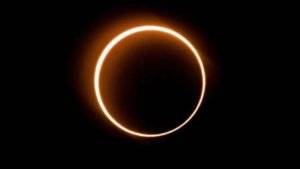![]()
The first solar eclipse of 2021, an annular solar eclipse, will occur on June 10 (Thursday), according to projections made by the National Aeronautics and Space Administration (Nasa). A “ring of fire” will be visible around the Moon from several regions across the world, a celestial phenomenon whereby the Sun’s halo is partially blocked by the lunar body. Although the annular solar eclipse will most prominently be visible in the northern hemisphere — in parts of northeast Canada, Greenland, and Siberia — Indians will be able to watch the annular solar eclipse 2021 online with the help of live stream options provided by Nasa and the Royal Astronomical Society of Canada Sudbury Centre.
Solar eclipse: What is a “ring of fire”?
NASA describes solar eclipse as an astronomical phenomenon that occurs when the Moon moves between the Sun and Earth, casting a shadow on the latter, fully or partially blocking the Sun’s light in some areas.
A total solar eclipse, as in when the Moon completely obscures the Sun, occurs because the Moon is about 400 times smaller than the Sun, but also 400 times closer, giving both the celestial bodies the same apparent size in the sky.
A partial solar eclipse occurs when the Moon’s orbit is not completely aligned with that of the Sun, thereby leaving a sliver of the solar halo.
Because the Moon’s orbit is not perfectly circular, it can sometimes appear slightly smaller than the Sun. When this happens, we witness an annular solar eclipse, where a “ring of fire” appears around the Moon due to the remnant halo of the Sun.
Solar eclipse of June 10, 2021
The annular solar eclipse of June 10, 2021, where a “ring of fire” appears around the Moon due to the remnant halo of the Sun, will mostly be visible in the northern hemisphere. In the UK and Ireland, people will witness a partial solar eclipse while most of India, barring a few cities, will be missing out on the celestial phenomenon.The solar eclipse on Thursday is expected to begin here shortly after noon, at 1:42pm. The peak time will come around 4:16pm, when both the Sun and the Moon will conjunct exactly at 25 degrees in the Taurus sign. After that, the phenomenon will begin to recede and the solar eclipse will finally end at 6:41pm.
About 35% of the Sun will be blocked out by the moon as viewed from Northern Ireland and Scotland, decreasing to about 20% in southeast England, according to Ryan Milligan, lecturer in astrophysics at Queen’s University Belfast and an avid solar eclipse chaser. “Most people will be oblivious to what’s going on above their heads, even with clear skies,” he said, adding that people need specially-approved solar eclipse glasses that reduce sunlight to safe levels to look directly at the Sun.







